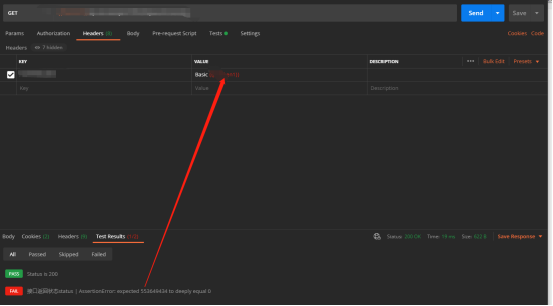1. 设置断言检测一些常见数据
//校验响应状态码
pm.test("Status is 200", function () {
pm.response.to.have.status(200);
});
// 断言状态码200-202区间
pm.test("Successful GET request", function () {
pm.expect(pm.response.code).to.be.oneOf([200,202]);
});
//校验接口返回状态
pm.test("接口返回状态status ", function () {
var jsonData = pm.response.json();
var status1 =jsonData.status
pm.expect(status1).to.eql(0);
console.log("status1 is :" +status1);
});
//断言响应时间小于200ms
pm.test("Response time is less than 300ms", function () {
pm.expect(pm.response.responseTime).to.be.below(3000);
});
//断言响应中包含某个字符串
pm.test("Body matches string", function () {
pm.expect(pm.response.text()).to.include("FRM");
});
//断言响应中的字段等于某个值
pm.test("message test", function () {
var jsonData = pm.response.json();
pm.expect(jsonData["message"]).to.eql("请求成功");
});
//断言响应中的字段不等于某个值
var jsonData = JSON.parse(responseBody);
tests["message不为failed"] = jsonData["message"] != "failed";
// // 断言响应中"list"的字段长度
// pm.test("data list test", function () {
// var jsonData = pm.response.json();
// pm.expect(jsonData["data"].length).to.eql(0);
// });
// 断言响应中"list 0的"的time字段的值
pm.test("data list 0 test", function () {
var jsonData = pm.response.json();
pm.expect(jsonData["data"][0]["time"]).to.eql("2018-11-28 17:27:41");
});
//测试解析json数据
pm.test("Your test name", function () {
var jsonData = pm.response.json();
pm.expect(jsonData.value).to.eql(100);
});
//检查header
pm.test("Content-Type is present", function () {
pm.response.to.have.header("Content-Type");
});
//测试是否等于某个字段
pm.test("Body is correct", function () {
pm.response.to.have.body("response_body_string");
});
//请求时间校验
pm.test("Response time is less than 200ms", function () {
pm.expect(pm.response.responseTime).to.be.below(200);
})
//返回值在某个区间
pm.test("Status code name has string", function () {
pm.response.to.have.status("Created");
})
//使用json schema 校验结果
var schema = {
"items": {
"type": "boolean"
}
};
var data1 = [true, false];
var data2 = [true, 123];
pm.test('Schema is valid', function() {
pm.expect(tv4.validate(data1, schema)).to.be.true;
pm.expect(tv4.validate(data2, schema)).to.be.true;
});
2. 常用Tests用法
1.检查response body中是否包含某个string
tests["Body matches string"] = responseBody.has("string_you_want_to_search");
注意:"Body matches string" 需唯一。
2.检测JSON中的某个值是否等于预期的值
var data = JSON.parse(responseBody);
tests["Your test name"] = data.value === 100;
JSON.parse()方法,把json字符串转化为对象。parse()会进行json格式的检查是一个安全的函数。
如:检查json中某个数组元素的个数(这里检测programs的长度)
var data = JSON.parse(responseBody);
tests["program's lenght"] = data.programs.length === 5;
3.检查response body是否与某个string相等
4.转换XML body为JSON对象
var jsonObject = xml2Json(responseBody);
tests["Body is correct"] = responseBody === "response_body_string";
5.测试response Headers中的某个元素是否存在(如:Content-Type)
tests["Content-Type is present"] = postman.getResponseHeader("Content-Type");
//getResponseHeader()方法会返回header的值,如果该值存在
或者:
tests["Content-Type is present"] = responseHeaders.hasOwnProperty("Content-Type");
上面的方法,不区分大小写。下面的方法,要区分大小写。
6.验证Status code的值
tests["Status code is 200"] = responseCode.code === 200;
7.验证Response time是否小于某个值
tests["Response time is less than 200ms"] = responseTime < 200;
8.name是否包含某个值
tests["Status code name has string"] = responseCode.name.has("Created");
9.POST 请求的状态响应码是否是某个值
tests["Successful POST request"] = response

2-若执行接口时 Tests报错或 Test Results 栏报错,则设置变量未生效,定义需要核查

3-获取响应的数据中 msg 的值(jsonData.msg),然后赋值给字符“msg”
var jsonData = JSON.parse(responseBody);
postman.setEnvironmentVariable("msg", jsonData.msg);
获取响应的数据中 msg 的值(jsonData.msg),然后赋值给字符“msg”
如: 响应数据是 "msg": "Custom error message notification"

在获取关联参数的时候可以设置一个environment,把获取的值放进去,给下个请求调用。
如果没有设置environment,则获取的参数不会被保存。
注意点:这里的脚本要看响应的返回形式来修改,如:
var jsonData = JSON.parse(responseBody);
postman.setEnvironmentVariable("uid", jsonData.result.uid);
这里响应返回的格式里面是 result数组下的uid,所以获取uid脚本是 jsonData.result.uid
